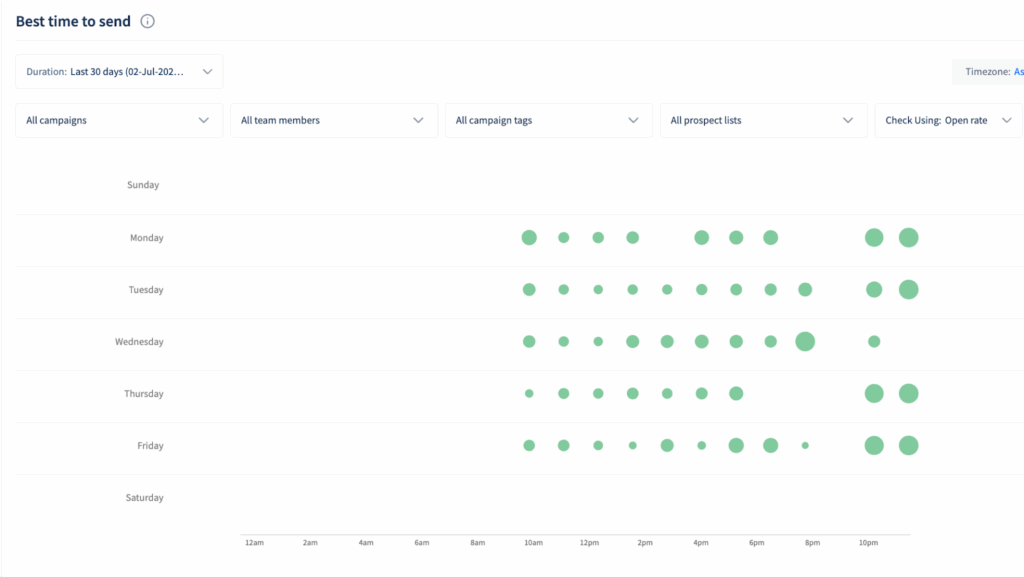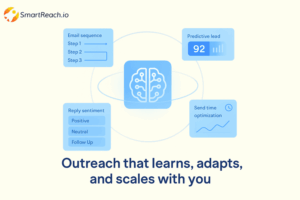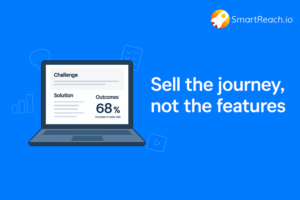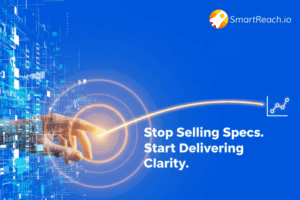How to Segment Your Audience for Better Email Engagement
You send 500 cold emails… and barely hear back from anyone. Maybe 5, maybe 8 replies, if you’re lucky.
The problem usually isn’t your offer.
It’s that you’re sending the same message to everyone.
A startup founder, a sales manager, a marketing head, all getting the exact same email. No wonder most people ignore it.
To them, it just feels like spam.
But when you break your audience into smaller, relevant groups and speak to their specific needs, things change fast.
That same 500 emails could bring in 50, even 75 responses!
Not because you emailed more. But because you emailed smarter.
In this article, we shall be discussing on different ways by which you can segment your email audience in a better way, leading to higher engagement.
Mass outreach vs. segmented campaigns
Mass outreach is when you send the exact same email to your entire list, no matter who they are. It’s quick, but also the easiest way to be ignored.
Segmented campaigns, on the other hand, break your list into smaller groups based on who they are and what they need. Instead of blasting one generic message, you send emails that feel relevant to each group.
For example:
- A startup founder gets a short email about saving time and costs.
- An enterprise manager sees a message focused on security and scalability.
- A marketing lead receives insights on improving lead quality.
The message changes, but the offer can stay the same. By speaking their language, your chances of getting a response go way up.
That’s why segmentation works: it makes your outreach feel personal, not spammy.
Why does sending emails to the wrong audience lead to spam problems?
Sending emails to the wrong people doesn’t just hurt your chances; it actively works against you.
When your message feels irrelevant, people mark it as spam, ignore it, or unsubscribe.
Email services such as Gmail, Yahoo, Outlook etc., track this behavior, and if enough people react that way, your future emails start landing in junk folders even for people who do want to hear from you.
On top of that, your email sender reputation takes a hit. Low engagement signals to email providers that your content isn’t worth showing.
Learn more about why sending emails to the wrong audience leads to spam problems.
How can I segment my audience to improve email engagement?
Segmentation isn’t about building 50 hyper-targeted email lists.
It’s about grouping people based on what they care about and where they are in their journey, so your emails actually make sense to them.
Key segmentation criteria
To make your emails more relevant, start by grouping prospects based on these factors:
Industry – Different industries have different challenges. Tailor your message to fit their world.
Company Size – Startups look for speed and affordability; enterprises value security and scale.
Job Title – A CEO cares about ROI, while a sales rep wants productivity tips.
Geography – Time zones, culture, and communication styles vary by region.
Pain Points – The most effective way to segment. Speak directly to what problem they’re trying to solve.
Even combining just two of these criteria can make your outreach feel more personal and boost response rates.
Here’s how you can do it without getting overwhelmed:
1. Segment by behavior: What are they actually doing?
Forget what people say. Focus on what they do. That’s where real intent lives.
- If someone visits your pricing page multiple times or requests a demo, they’re clearly interested. These are your hot leads.
- Someone who downloads an ebook or opens a few emails? Warm lead.
- Barely any interaction at all? Cold.
And it’s not just about clicks – look at what they’re clicking.
A person downloading beginner guides is likely earlier in their journey than someone reviewing case studies or ROI calculators.
Match your follow-ups to that level of interest.
Example: If someone downloads an “ROI Calculator” but skips your pricing emails, they’re curious but not ready to buy. Send educational content instead of pushing a sale.
2. Segment by profile: Who are they, and what do they need?
A company’s size, the industry they’re in, and someone’s job title all change how you should talk to them.
- Startups want speed, ease of setup, and cost savings.
- Enterprises care more about security, scalability, and onboarding support.
- Job titles matter too. Executives want to hear about ROI, while technical folks want to understand how things work. Procurement? They want competitive comparisons.
For example:
You wouldn’t send the same email to a founder at a 10-person startup and a compliance officer at a healthcare enterprise, right?
Different roles, different pain points.
3. Segment by engagement: Cold, warm, hot, or already a customer
Where someone is in your sales funnel should guide your messaging tone and intensity.
- Cold prospects don’t know you. Share helpful content, industry trends, short guides, or relatable problems they might be facing.
- Warm leads have shown interest. They’ve clicked, opened, or visited your site. Now’s the time for gentle nudges like, “Want to see how this works?”
- Hot leads are clearly evaluated. Send them pricing, case studies, and invite them to take action.
- Past customers? Focus on new features, upsells, or referral asks.
Pushy emails to cold leads?
That’ll kill engagement.
Soft touches to hot leads? Missed opportunity.
Read more: How to Nurture Cold Leads: 10 Strategies
4. Segment by preferences: Respect how people like to be contacted
Not everyone likes the same stuff.
Some people love detailed breakdowns. Others want bullet points. Some open every email at 10 AM. Others skim them at 4 PM.
Track what content types they interact with, videos, case studies, quick tips, and how often they want to hear from you.
Tools like SmartReach.io can help you track when people opens, clicks, or replies to your emails and best send times to send them emails.

That way, you reach people in the way they prefer, not the way you assume.
5. Segment by roles and responsibilities
Even in similar companies, priorities change with roles.
A marketing director, sales manager, and operations head will all care about different benefits from the same tool.
- Sales wants better productivity and more closed deals.
- Marketing cares about lead quality and conversion.
- Operations is focused on smooth rollout and zero disruption.
Same product, but the message should shift depending on what keeps each person up at night.
How segmentation boosts response rates
Generic emails get ignored because they don’t feel relevant.
When you segment, you match your message to what each group actually cares about, and that’s what makes people respond.
Studies show segmented campaigns can drive up to 3x higher open rates and significantly more replies compared to mass outreach.
Even simple segmentation, like adjusting your message by job title or company size, can make a big difference.
Think of it this way: if you send 500 generic emails, maybe 5–8 people reply. But if you break that same list into smaller, targeted groups, you could see 50–75 replies.
The volume stays the same, but the results multiply because your emails finally feel worth reading.
How to email create content that matches each segment
Once you’ve grouped your audience, tailor your messaging to each audience.
Here’s a quick guide:
- Subject lines
- Cold: “Quick question about [industry] trends”
- Warm: “Following up on your [action]”
- Hot: “Ready to talk pricing?”
- Cold: “Quick question about [industry] trends”
Recommended Read: 165 B2B Cold Email Subject Lines For Sales Outreach
- Email content
- Cold: One benefit, light CTA
- Warm: A few key benefits + social proof
- Hot: Detailed offer, clear next steps
- Cold: One benefit, light CTA
- Call-to-action examples
- Cold: “Here’s a quick resource I thought you’d like”
- Warm: “Want to chat for 10 minutes this week?”
- Hot: “When works for your team to get started?”
- Cold: “Here’s a quick resource I thought you’d like”
Start with just three segments: cold, warm, and hot.
Base it on opens, clicks, and visits.
As your email list grows and your insights deepen, you can layer in more details like job titles, industries, or behavior patterns.
Review your segments every month.
They’re not set in stone. People’s behavior changes, so your approach should too.
How SmartReach.io makes segmentation simple
Segmentation sounds complicated, but with SmartReach.io, it’s built into the workflow.
You don’t need endless spreadsheets or manual sorting; our platform helps you create and manage targeted lists in just a few clicks.
Here’s how SmartReach.io supports better segmentation:
- Custom Filters & Tags: Easily group prospects by industry, job title, geography, or any field you choose.
- Behavior Tracking: Automatically track opens, clicks, and replies so you know who’s cold, warm, or hot.
- Personalized Messaging: Send tailored emails to each segment without writing multiple campaigns from scratch.
This way, your outreach stays relevant, organized, and scalable, without the manual headache.
Try SmartReach.io FREE for 14 days
FAQ on better segmentation for improved email engagement
How many segments should I start with?
Start with 3-5 segments maximum. Too many segments create management overhead without better results. Focus on clear behavioral or demographic differences that require different messaging approaches.
What’s the minimum list size needed for segmentation?
You need at least 100 contacts per segment to get meaningful data. If your total list is under 500 people, start with just 2-3 segments until you grow your audience.
How often should I update my segments?
Review segment performance monthly and update criteria quarterly. However, automate movement between engagement-based segments (cold to warm to hot) so prospects move immediately when they show interest.
Can I automate segmentation?
Yes, most email platforms and CRM systems can automatically segment based on behaviors like email opens, website visits, and form submissions. Set up rules for common transitions like moving prospects from cold to warm based on engagement.
What if a prospect fits multiple segments?
Prioritize behavioral segments over demographic ones. For example, if someone fits both “Enterprise” and “Hot Prospect” segments, treat them as hot first. Engagement level usually matters more than company characteristics.
How do I segment without enough data on prospects?
Start with basic information you can gather: company size (from LinkedIn), industry (from website), and job title. Use email engagement behavior to create your first segments, then gather more data over time through surveys or progressive profiling.
What tools do I need for effective segmentation?
A CRM system that tracks email engagement and basic contact information covers most segmentation needs. Tools like SmartReach.io offer advanced segmentation features including behavioral tracking and automated list management for more sophisticated campaigns.




